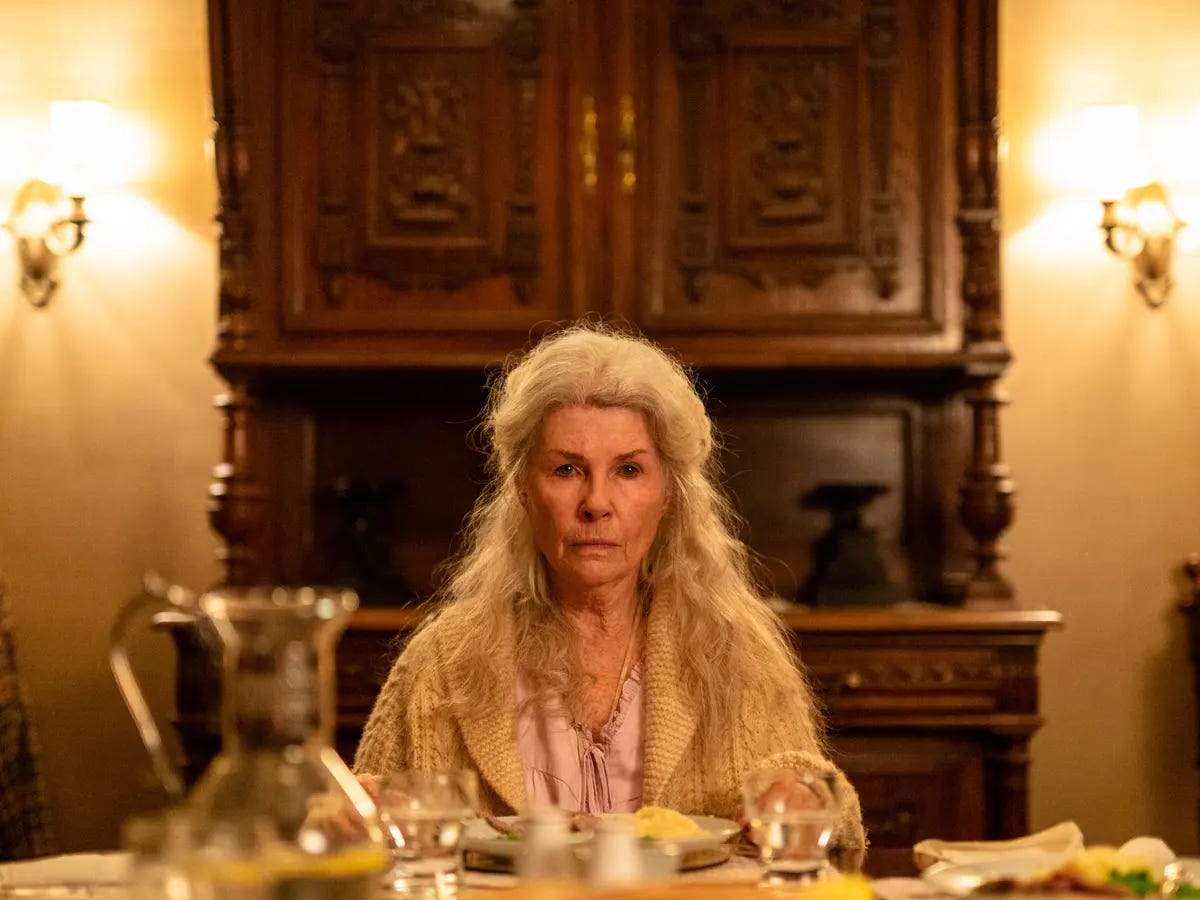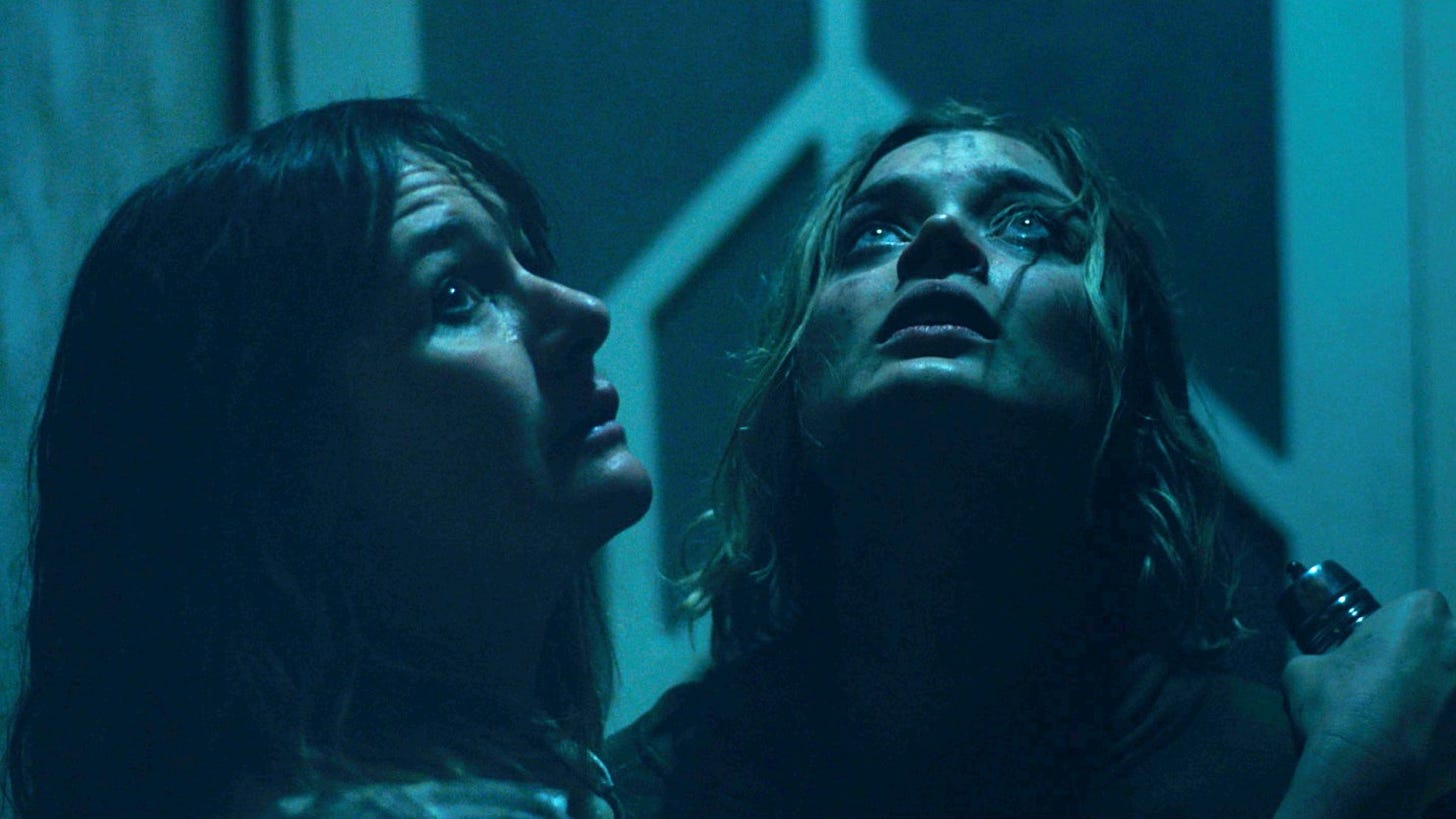On Memory, Parents, and ‘Relic’
Natalie Erika Jane’s debut draws from the experience of caring for parents with dementia. It's an unsettling film that's doubled as an unexpectedly comforting mirror to the past few years of my life.
It’s only when things have gone past the point of return that Kay (Emily Mortimer) realizes she should have taken the warning signs more seriously. Speaking to the police in the small Australian town she left behind for Melbourne in Natalie Erika Jane’s 2020 feature debut Relic, Kay instinctively downplays evidence of her mother Edna’s (Robyn Levin) dementia, even after learning Edna has disappeared from her home. “She’s in her eighties,” Kay says, as she loses the ability to convince herself things are still basically OK. “She forgets things. She managed to flood the house last Christmas.” In that moment, she seems to realize that the Christmas flood might have receded, but another could soon swallow them up.
At Edna’s home, Kay and her daughter Sam (Bella Heathcote) find the bed unmade, the dishes unwashed, and once-tidy spaces overtaken by clutter. They also discover post-it notes with messages like “Take pills” and, more ominously, “DON’T FOLLOW IT.” As the search continues, Kay and Sam encounter other suggestions that Edna has changed since last they saw her, as when Jamie (Chris Bonton), a sweet neighbor with Down Syndrome, reveals his father won’t let him visit Edna anymore. More ominous still, though they go unnoticed by Kay and Sam at first: a black growth that appears to be mildew spreading through the house at an alarming rate and a figure lurking in the shadows of the house.
Inspired by Jane watching her grandmother’s experience with Alzheimers, Relic is a horror movie, but only barely. Jane fills the film with a mounting sense of dread and incidents of increasing intensity. Though Relic’s point of departure into fantasy arrives relatively late, there’s much horror before that point. When Edna returns, she’s herself, but not really, or at least not all the time. In one scene, she tenderly gives her wedding ring to Sam. A few scenes later, she lashes out and accuses Sam of stealing it from her. Edna lives in a fog of confusion that thins but never lifts. In the final act, Kay and Sam get pulled into it as they wander an endless labyrinth folded into the walls of Edna’s house, a place where the clutter has spread with the persistence of the mold on the walls. Relic doesn’t so much make a horror movie of this situation as push it a few degrees into the realm of metaphor.
When Relic arrived on VOD in 2020, its theatrical run limited by the pandemic, I watched it with nods of recognition, seeing reflections of my past experience and what I suspected lay ahead. My father first manifested symptoms of dementia after a car accident in 2007. It was unclear how much the accident hastened the condition because he was a quiet man who’d lived by the same routines since retiring in the mid-’80s and was always happy to let my mother do the talking. I’m haunted now by an offhand reference he once made to not being able to remember things like he used to, a statement I waved away at the time by telling him that just happens when you get older. The thought of it being anything more serious was unbearable.
My mother’s dementia also debuted in the company of other troubles in December 2018. On phone calls from Chicago to my hometown in Ohio, she sounded increasingly weak, her voice reduced to a croak even as she remained insistent that she’d be okay. She’d lived alone, well enough, since my father died nine years earlier, but I’d spent those years fearing something like this could happen. On a Saturday when she seemed worse than ever, I drove to Ohio without telling her I was coming. By the time I arrived, she’d already been hospitalized with what seemed at the time like a nasty respiratory infection—until x-rays revealed some spots on her lungs.
Over the course of the subsequent hospital stay, nursing home recovery, and a disastrous stint in which she received 24-hour home care (at least once inspiring her care providers to quit mid-shift), Mom seemed increasingly confused and hostile, unable to process what was going on. Why was she in this motel? Why were these people in her house? But, after some time passed, she settled back into her old life with her faculties more or less reverting back to the way they were. With some help from friends, she was able to make a biweekly chemo appointment that kept the cancer locked into a stalemate and seemed like herself again as she lived an only slightly more supervised version of her old life.
In the end, this was just an interregnum, a plateau before the descent continued. During a visit to us in Chicago shortly before Thanksgiving 2021, the evidence that her dementia was worsening became impossible to ignore. We took her shopping and she asked repeatedly if the mall we were visiting had a Macy’s—the first time just a few steps outside the Macy’s we’d just left. A few weeks later, after returning to Ohio, she was hospitalized with pneumonia after a week of barely eating and only erratically taking her medicine.
I knew then she couldn’t live alone but spent the next year struggling with her, trying to coax her to move to a retirement home near us or, failing that, one in Ohio. But legally, there was nothing I could do except plead my case to a woman increasingly untethered to reality. In Relic, a doctor gives Edna a check-up shortly after her return. After Edna answers a few basic questions, she more or less leaves her to her own devices while expressing some concern about the dark spot on her chest that looks a lot like whatever’s growing on her walls. The doctor suggests she not be alone for the next couple of weeks.
My experience was frustratingly similar. Though it was obvious that my mother’s dementia was debilitating and she’d named me power of attorney just in case such a scenario happened, enacting that power of attorney proved elusive. During her 2021 hospitalization, after maybe spending two minutes with her, an ER doctor declared her capable of making her own decisions despite my mother loudly insisting she’d call the sheriff to arrest me if I didn’t release her from this hotel. Her primary care doctor retired, and after my mother no-showed several appointments, her practice dropped her, leaving her without a general practitioner and no one to evaluate or diagnose her deteriorating mental health. In the end, after a hellish year filled with worry and anger during which her condition steadily, sometimes dramatically, worsened, I was able to move her to a memory care unit ten minutes from my home in Chicago. She left behind a house covered in unpaid bills and handwritten reminders to perform basic tasks, and scattered among them, a note reading—in a shakier version of the once-immaculate penmanship honed as an elementary school teacher—“I am not leaving my house.”
Now she’s settled in. I see her almost every day. She’s not getting better but she’s safe and near. It’s not a happy ending, exactly, but it’s better than what might have happened.
I’m not sharing this story because it’s extraordinary but because it’s not. It’s common fears and experiences that make horror resonant, and I know countless others have stories similar to my own. At some point, they all turn into horror stories. I’d seen other movies about dementia, some excellent. (At one point I bitterly joked that I was living The Savages while my mom thought she was living Gaslight.) None of them captured the experience of watching a loved one in the grips of the condition quite as well as Relic. Done well, horror has a way of tapping directly into the emotions we try to repress and ignore in ways no other genre can.
This hasn’t been everyone’s reaction to the film. I’ve talked to others with similar family experiences who find the film repulsive, treating Edna as a monster who’s lost her humanity, particularly in the final scene in which Kay peels back Edna’s skin until she resembles the dark specter haunting the house (itself, the film implies, the spirit of a past relative who similarly succumbed to dementia). I understand this reaction. It’s undeniably a moment of body horror (Jane has cited Cronenberg as an influence), but to my eyes, it’s played less as a moment of repulsion than acceptance. Gazing at what her mother has become, Kay realizes that Edna has been transformed but hasn’t disappeared. As Sam lays down beside her mother and grandmother, she sees a familiar-looking dark spot, though a still-faint one, growing on her mother’s back. In time, they’ll come for Sam, too.
Dementia is, in most cases, not hereditary. But it’s also not uncommon. I hope to dodge it but, having seen it claim both my parents, I fear it for myself, a fear stoked by the inevitable slowing of recall in middle age. My memories are still there, just harder to access. Yet spinning the wheels to come up with information I know and should know takes on an added anxiety seeing what I’ve seen. (A snippet of a conversation I had the other night: “You know, the movie the Wachowskis did… with Tom Tykwer.. It’s long… It’s based on a novel I liked… David Mitchell wrote it: Cloud Atlas!”) Jane’s film does nothing to quell those fears for ourselves or others or ease the experience of helping a loved one succumbing to dementia. But there’s comfort in the way Relic acknowledges these feelings and experiences are real and awful and human. And that turning away from them can’t make them disappear.






Great piece, Keith. I'm glad things have reached some sort of stability for both you and your mother.
Loved this, Keith. Glad to hear that the situation has stabilized somewhat. (I remember that November in 2021.)